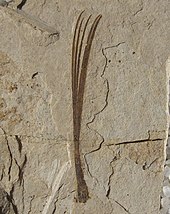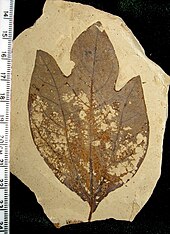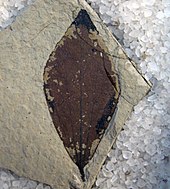Klondike Mountain Formation
| Klondike Mountain Formation Stratigraphic range: Ypresian | |
|---|---|
 Klondike Mountain Formation outcrop at site A0307 | |
| Type | Geological formation |
| Unit of | |
| Sub-units | Tom Thumb Tuff, Lower & Upper Members |
| Underlies | Glacial deposits |
| Overlies | & others |
| Thickness | up to 3,200 ft (980 m) |
| Lithology | |
| Primary | Variable |
| Other | See text |
| Location | |
| Coordinates | 48°42′N 118°42′W / 48.7°N 118.7°WCoordinates: 48°42′N 118°42′W / 48.7°N 118.7°W |
| Approximate paleocoordinates | 54°24′N 101°54′W / 54.4°N 101.9°W |
| Region | Okanagan highlands |
| Country | |
| Extent | Okanagan highlands |
| Type section | |
| Named for | |
| Named by | Muessig |
| Year defined | 1962 |
 Klondike Mountain Formation (the United States) | |
The Klondike Mountain Formation is an Early Eocene (Ypresian) geological formation located in the northeast central area of Washington state. The formation, named for the type location designated in 1962, Klondike Mountain north of Republic, Washington, is composed of volcanic rocks in the upper unit and volcanics plus lacustrine (lakebed) sedimentation in which a lagerstätte with exceptionally well-preserved plant and insect fossils has been found, along with fossil epithermal hot springs.
The formation is the youngest in a group of formations which belong to the Challis Sequence rocks. The formation unconformably overlies rocks of the Eocene and much older Triassic and Permian formations. The formation is bounded on its edges by a series of high-angle strike slip faults, which have contained the Klondike Mountain Formation in a series of graben structures, such as the Republic Graben. Public access to a fossiliferous outcrop at the north end of Republic is mediated by the nonprofit Stonerose Interpretive Center.
Extent[]
The formation is located in northern Ferry County, Washington, with the majority of the sedimentation in the Republic and Curlew Basins on the east and in the Toroda Creek area to the north west. The town of Republic, Washington is situated at the southern end of the formation, with outcrops within the city itself. The formation was named for Klondike Mountain which is just to the northeast of the city, and where the type locality is located.[1] The Curlew basin is situated north of Republic, with the northern edge along the Kettle River and the community of Curlew, Washington near the northeastern edge.[2][3]
The formation is the southernmost of a string of preserved Eocene highland lakebeds in Washington state and British Columbia.[4] The lake system, within the Okanagan highlands, extends from the Klondike Mountain Formation north approximately 1,000 kilometres (1,000,000 m) in to southern central British Columbia.[5]
Age[]
Early dating of the formation was based primarily on identification and correlation of the fossils found in the Tom Thumb Tuff, with Joseph Umpleby (1910) reporting a putative age of Early Miocene.[6] This date was based in examination of fossils by C. R. Eastman, who thought them to be similar to those found in the Florissant Formation of Colorado, which at the time was also considered Miocene. This age was retained by Edward W. Berry (1929), who included the Klondike Mountain Formation fossil lakebeds as part of the Latah Formation.[7] The age of the Formation has been revised in the following hundred years, with Roland W. Brown (1936) identifying the deposits as being older than the Latah Formation.[8] In a later written communication circa 1958, Brown again revised the age still older, stating the fossils found in the area of Mount Elizabeth indicated an Oligocene age. This age was used by Parker and Calkins (1964) for work on the Curlew Quadrangle of Ferry County.[9] Work by Pearson and Obradovich (1977) refined the Sanpoil Volcanics age to between 52 to 51 million years ago, and a general age estimate for the Klondike Mountain Formation between 50.3 ± 1.7 million years ago and 42.3 ± 2.0 million years ago.[10] Since then the fossil-bearing strata of the Formation have been radiometrically dated, to give an estimate of the Ypresian, the mid stage of the early Eocene,49.4 ± .5 million years ago,[5] which was revised to an oldest age estimate of 51.2 ± 0.1 million years ago which given based on detrital zircon isotopic data published in 2021.[11]
Lithology[]
Parker and Calkins (1964) noted the association of the Klondike Mountain Formation with the gold and silver deposits of the Republic District and suggested it as a potential host to more ore deposits in the Curlew Quadrangle.[9] The epithermal gold deposits occurring in the Sanpoil volcanics terminate directly below the unconformity where the volcanics contact the base of the Klondike Mountain Formation[12] or sometimes penetrate into the Formation's lowest unit.[13] Hydrothermal sinter deposits are known from the lowest portions of the Formation and are thought to represent hydrothermal eruption areas.[13] In general the lower portions of the Formation have a large amount of hydrothermal alteration, and areas around vents are rich in pyrite and silica. two products of natural hydrothermic sintering. The areas above that show a transition to mudstones, siltstones and sandstones grading from fine-grained material into coarser materials moving up the strata column. The finely-bedded stones show the greatest numbers of fossils and the finest preservation of details.[14]
Paleoenvironment and paleoclimate[]
The lake bed sediments preserve a diverse array of plants, insects, and fishes, notably the biota called the Republic flora.[15] The Okanagan lake system, which includes the Klondike Mountain Formation, has been classified as one of the great Canadian lagerstätten.[16] The area likely had a mesic upper microthermal to lower mesothermal climate, in which winter temperatures rarely dropped low enough for snow, and which were seasonably equitable.[17]
The Okanagan highlands paleoforest surrounding the lakes have been described as precursors the to modern Temperate broadleaf and mixed forests of Eastern North America and Eastern Asia. Based on the fossil biotas the lakes were higher and cooler then the coeval coastal forests preserved in the Puget Group and Chuckanut Formation of Western Washington, which are described as lowland tropical forest ecosystems. Estimates of the paleoelevation between 0.7–1.2 km (0.43–0.75 mi) higher than the coastal forests. This is consistent with the paleoelevation estimates for the lake systems, which range between 1.1–2.9 km (1,100–2,900 m), which is similar to the modern elevation 0.8 km (0.50 mi), but higher.[17]
Estimates of the mean annual temperature have been derived from Climate leaf analysis multivariate program (CLAMP) and leaf margin analysis (LMA) of the Republic paleoflora. The CLAMP results after multiple linear regressions for Republic gave a mean annual temperature of approximately 8.0 °C (46.4 °F), while the LMA gave 9.2 ± 2.0 °C (48.6 ± 3.6 °F). This is lower than the mean annual temperature estimates given for the coastal Puget Group, which is estimated to have been between 15–18.6 °C (59.0–65.5 °F). The bioclimactic analysis for Republic suggests a mean annual precipitation amount of 115 ± 39 cm (45 ± 15 in).[17]
Paleobiota[]
The formation is host to a highly diverse assemblage of plants and insects including some of the last records of taxa before extinction and the first appearances of taxa.
Lycophytes[]
| Family | Genus | Species | Authors | Year | Notes | Images |
|---|---|---|---|---|---|---|
|
Selaginellaceae |
Selaginella |
Undescribed[18] |
A spikemoss |
Pteridophytes[]
| Family | Genus | Species | Authors | Notes | Images |
|---|---|---|---|---|---|
|
Cystopteridaceae |
Undescribed[18] |
A possible bladder fern relative |
|||
|
Equisetum |
A scouring rush |
||||
|
Lygodiaceae |
Lygodium |
A climbing fern |
|||
|
†Azolla primaeva[20] |
Arnold |
A mosquito fern |
 Azolla primaeva | ||
|
Salvinia |
Undescribed[21] |
A "watermoss" species. |
Gymnosperms[]
Three major groups of gymnosperms are present in the Klondike Mountain Formation, with the most speciose being the pinophytes. The ginkgophytes are represented by two species pf Ginkgo, while an undescribed Zamiaceae member is the sole cycadophyte.
Cycadophytes[]
| Family | Genus | Species | Authors | Notes | Images |
|---|---|---|---|---|---|
|
Zamiaceae |
Undescribed |
A zamiaceous cycad. |
 Undescribed zamiaceous leaf |
Gingkophytes[]
| Family | Genus | Species | Authors | Notes | Images |
|---|---|---|---|---|---|
|
Ginkgo |
†Ginkgo biloba[24] |
Linnaeus |
A ginkgo |
 Ginkgo biloba | |
|
Ginkgo |
†Ginkgo dissecta[24] |
|
A ginkgo |
 Ginkgo dissecta |
Pinophytes[]
| Family | Genus | Species | Authors | Notes | Images |
|---|---|---|---|---|---|
|
Cupressaceae |
Calocedrus |
An incense cedar |
|||
|
Cupressaceae |
Chamaecyparis |
Undescribed[26] |
A false cypress |
||
|
Cupressaceae |
Cryptomeria |
A sugi |
|||
|
Cupressaceae |
Glyptostrobus |
Undescribed[26] |
A Chinese swamp cypress |
||
|
Cupressaceae |
Metasequoia |
(Newberry) Chaney |
A dawn redwood |
||
|
Cupressaceae |
Sequoia |
Lesquereux |
A coast redwood |
||
|
Cupressaceae |
Undescribed[21] |
A Taiwania species |
|||
|
Cupressaceae |
(Sternberg) Heer |
||||
|
Cupressaceae |
Thuja |
Undescribed[26] |
An arborvitae |
||
|
Pinaceae |
Abies |
& Wehr |
Oldest true fir described |
||
|
Pinaceae |
Picea |
Undescribed[26] |
A spruce |
||
|
Pinaceae |
Pinus |
Berry |
A 5 needle pine |
||
|
Pinaceae |
Pinus |
†[7] |
Berry |
A 3 needle pine, jr homonym to Pinus macrophylla Lindley 1839 |
 |
|
Pinaceae |
Pinus |
†[7] |
Berry |
A pine seed morphogenus |
 |
|
Pinaceae |
Pinus |
†[7] |
Berry |
A possible 4 needled pine |
|
|
Pinaceae |
Gooch |
A golden larch |
|||
|
Pinaceae |
Tsuga |
Undescribed[26] |
A hemlock |
||
|
|
Sciadopitys |
Undescribed[26] |
An umbrella pine |
 Sciadopitys species | |
|
Undescribed[26] |
A yew |
 Amentotaxus sp. | |||
|
Cephalotaxus |
Undescribed[26] |
A yew |
|||
|
Undescribed[26] |
A yew |
Flowering plants[]
Angiosperms, commonly called flowering plants belong to a single plant clade which diverged from other plants during the prior to the Cretaceous, and began to rapidly evolve and radiate by the Middle Cretaceous.[32] Angiosperm diversification during the Cretaceous and Paleocene resulted in eight recognized clades that are segregated into two groups the Basal angiosperms and Core angiosperms. Present in the Klondike Mountain Formation are four of the eight groups, Nymphaeales representing Basal Angiosperms, plus Magnoliids, Monocots, and Eudicots all in the Core angiosperms.
Nymphaeales[]
The Basal Angiosperms are represented by a single Nymphaeales water-lily species Nuphar carlquistii.,[33] though a second member, , has been described from the Princeton Chert.[34] Wehr (1995) illustrated two fossils that were tentatively identified as fruits of the banana genus Ensete and the extinct myrtle genus respectively,[35] however further fossil finds resulted in the re-identification of the first as a N. carlquistii rhizome section, and the second is a seed mass from the same water-lily.[33]
| Family | Genus | Species | Authors | Notes | Images |
|---|---|---|---|---|---|
|
Nymphaeaceae |
†Nuphar carlquistii[33] |
DeVore, Taylor, & Pigg |
A waterlily, |
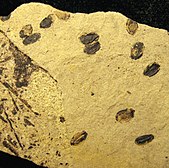 Nuphar carlquistii seeds |
Magnoliids[]
Under the APG IV system of flowering plant classification, the magnoliids are divided into four orders Canellales, Laurales, Magnoliales, and Piperales. Member species and undescribed taxa placed confidently in the Laurales and Magnoliales are present in the formation. The laurales are the most diverse magnoliid order of the formation with one described species Sassafras hesperia plus three tentatively identified genera which have not been described. Of the magnoliales, only an undescribed Magnolia, having possible affinity with Magnolia subg. Talauma, is found in the formation, while has described from permineralized wood in the Princeton Chert.[36] The extinct angiosperm genus Dillhoffia has noted similarities to the piperalean family Aristolochiaceae, but was left incertae sedis as to family by Manchester and Pigg (2008) due to a lack of confident morphological characters for placement. Piperales are known from the Princeton chert, with representing the oldest confident Saururaceae species in the fossil record.[37]
| Family | Genus | Species | Authors | Notes | Images |
|---|---|---|---|---|---|
|
Lauraceae |
† |
Undescribed[18] |
A lauraceous form species. |
||
|
Lauraceae |
Ocotea |
Undescribed[18] |
A stinkwood species. |
||
|
Lauraceae |
Phoebe |
Undescribed[15] |
A Phoebe species. |
||
|
Lauraceae |
Sassafras |
Berry |
A sassafras |
||
|
Magnoliaceae |
Magnolia |
Undescribed[38] |
A magnolia, possibly Magnolia subgenus Talauma |
||
|
†Dillhoffia cachensis[39] |
Manchester & Pigg |
A flower of uncertian floral affinity |
 Dillhoffia cachensis |
Monocots[]
The second largest clade of flowering plants, monocots are divided into eleven separate orders and of those, the Alismatales, Asparagales, Liliales, and Poales are found in the Klondike Mountain Formation, each represented by a single taxon. The Alismatales are represented by the Araceae species Orontium wolfei, which is considered similar to the modern golden clubs of eastern North America, while the extinct belongs to the Liliales. Asparagales and Poales are both present as undescribed species associated with the genera Smilax and Typha respectively. Extinct genera of monocots are also represented in the Princeton chert by the arecalean palm ,[40] the alismatalean genus ,[41] the alismatalean ,[42] the asparagalean pollen morphogenus ,[43] the lilialean genus ,[44] and the poalean genus ,[45]
| Family | Genus | Species | Authors | Notes | Images |
|---|---|---|---|---|---|
|
Amaryllidaceae |
† |
†[46] |
Pigg, , & DeVore |
An onion relative |
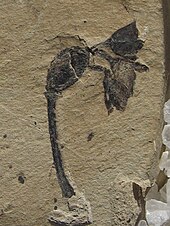 |
|
Araceae |
†Orontium wolfei[47] |
Bogner, Johnson, & Upchurch |
A golden club |
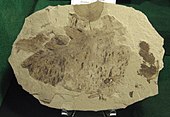 Orontium wolfei | |
|
Smilax |
Undescribed[18] |
A greenbrier species. |
|||
|
Typhaceae |
Typha |
Undescribed[18] |
A cattail species. |
Eudicots[]

Over a dozen different Rosaceae genera, both extant and extinct, have been identified in the formation providing some of the oldest reliable macrofossil records (excluding fossil pollen) for the family.[48] Benedict et al. (2011) described first fossils for the prunoid genus Oemleria along with the oldest Prunus flowers. The Prunus flowers are complimented by leaf fossils representeding five to six distinct morphotypes.[49] Spiraea is known from an with multiple flowers and leaves that are either from the genus or a closely related extinct type. The leaves frequently are preserved with a persistent stipule, a feature not found in modern Spiraea species. The firethorn genus Pyracantha and the South American genus Hesperomeles have been tentatively identified from leaves while leaves belonging to either Malus or Pyrus have been found. Two distinct species of the Asian endemic genus Photinia are known, however only on of them had been described as of 2007.[49] The rosaceous genus Physocarpus had been reported by Hopkins and Wehr (1994) as also occurring in the formation,[38] however subsequent examination of the fossils by Oh & Potter (2005) failed to find stellate trichomes which are a distinct feature of the genus. They noted the fossils might be stem Neillieae, the rose tribe containing both Physocarpus and Neillia, or possibly Rubus, Crataegus, or Ribes.[50]
Fossils of both Sorbus and Rhus species leaves showing evidence of being interspecies hybrids have been noted from the formation and Flynn, DeVore and Pigg (2019) described four species of sumac which formed multiple hybrids.[51] Between three and four Trochodendraceae species that have been described from the Klondike Mountain Formation. Broadly circumscribed four species in three genera have been identified at Republic, Paraconcavistylon wehrii, Pentacentron sternhartae, Tetracentron hopkinsii, and Trochodendron nastae. Additionally the species Trochodendron drachukii is known from related Kamloops group shales at the McAbee Fossil Beds near Cache Creek, British Columbia. Manchester et al. 2018 noted that Tr. drachukii is likely the fruits of Tr. nastae, while Pe. sternhartae are likely the fruits of Te. hopkinsii.[52] If fossils of the fruits and foliage in attachment are found, that would bring the species count down to three whole plant taxa.[52] Additionally, the extinct genus is also known from the formation. The placement of Nordenskioldia is debated, with some treatments placing it into Trochodendraceae, while a 2020 analysis placed it outside of the crown-group Trochodendaceae.[53] Wesley Wehr in 1994 reported Bignoniaceae seeds along with a single Rubiaceae fruit and an isolated Fabaceae leaf.[54] An update of the floral list by Wehr and Manchester published in 1996 added an additional fifteen taxa identified from reproductive structures such as flowers fruits or seeds.[35]
Pigg, Manchester, and Wehr (2003) noted in during the description of Corylus johnsonii and Carpinus perryae that they were the oldest confirmed hazelnut and hornbeam fossils.[55] That status was affirmed by Forest et al. (2005) who used both as fossil calibration points for phylogenetic analysis of Betulaceae.[56]
| Family | Genus | Species | Authors | Notes | Images |
|---|---|---|---|---|---|
|
Anacardiaceae |
Rhus |
Flynn, DeVore, & Pigg |
A sumac, |
||
|
Anacardiaceae |
Rhus |
Flynn, DeVore, & Pigg |
A sumac, |
||
|
Anacardiaceae |
Rhus |
(Wolfe and Wehr) Flynn, DeVore & Pigg |
A sumac, |
||
|
Anacardiaceae |
Rhus |
Flynn, DeVore, & Pigg |
A sumac, |
||
|
Ilex |
Undescribed[17] |
A holly |
|||
|
Araliaceae |
Aralia |
Undescribed[23] |
A spikenard species |
||
|
Betulaceae |
Alnus |
(Berry) Wolfe & Wehr |
An Alder |
 | |
|
Betulaceae |
Betula |
Wolfe & Wehr |
A birch |
 Betula leopoldae | |
|
Betulaceae |
Carpinus |
Pigg, , & Wehr |
A hornbeam |
||
|
Betulaceae |
Corylus |
Pigg, , & Wehr |
A hazel nut |
||
|
Betulaceae |
† |
†[55] |
Pigg, Manchester, & Wehr |
A birch relative |
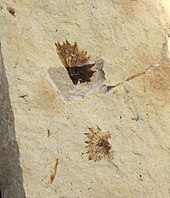 |
|
Betulaceae |
† |
Undescribed[55] |
A birch relative |
 undescribed species | |
|
Bignoniaceae |
Undescribed |
Undescribed[54] |
A catalpa family member |
 Bignoniaceae sp. fruit | |
|
†Barghoornia oblongifolia[15] |
Wolfe & Wehr |
An extinct Bursera relative |
 Barghoornia oblongifolia | ||
|
Celtidaceae |
Undescribed[58] |
A cannabaceous fruit |
 Pteroceltis species fruit | ||
|
Cercidiphyllaceae |
†[15] |
(Dawson) Wolfe & Wehr |
A katsura with suggested affinity to †,[23] |
 | |
|
Cornaceae |
Cornus |
A dogwood species, |
|||
|
Undescribed[58] |
An elaeocarpaceous fruit |
 Sloanea sp. | |||
|
Ericaceae |
Arbutus |
A madrone relative |
|||
|
Ericaceae |
Rhododendron |
A rhododendron |
|||
|
Ericaceae |
Cf. Leucothoe |
Undescribed[38] |
A doghobble relative |
||
|
Eucommiaceae |
Brown |
A "hard rubber tree" |
 Eucommia montana | ||
|
Fagaceae |
† |
Undescribed[17] |
A Castanea relative |
||
|
Fagaceae |
† |
†[15] |
(Knowlton) Hollick |
A beech relative |
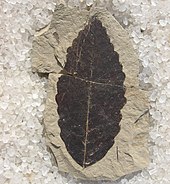 |
|
Fagaceae |
Fagus |
†[60] |
Manchester & Dillhoff |
A beech |
 |
|
Fagaceae |
Quercus |
An oak |
|||
|
Ribes |
A current |
||||
|
Ribes |
"Species2"[38] |
A current |
|||
|
Hamamelidaceae |
, , & Wehr |
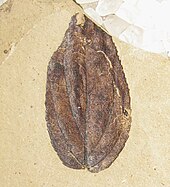 Corylopsis reedae | |||
|
Hamamelidaceae |
Fothergilla |
†Fothergilla malloryi[61] |
Radtke, Pigg, & Wehr |
A witch alder |
 Fothergilla malloryi |
|
Hamamelidaceae |
†Langeria magnifica[15] |
Wolfe & Wehr |
A witch hazel relative |
 Langeria magnifica | |
|
Hydrangea |
Undescribed[38] |
A Hydrangea. |
|||
|
Undescribed[38] |
A mock-orange |
||||
|
Icacinaceae |
|
A Phytocrene relative |
|||
|
A virginia willow species |
|||||
|
Juglandaceae |
Carya |
A walnut family relative. |
|||
|
Juglandaceae |
† |
†[62] |
(Brown) Manchester |
A walnut family relative. |
|
|
Juglandaceae |
Juglans |
A walnut family relative. |
|||
|
Juglandaceae |
Pterocarya |
Undescribed[54] |
A wing nut |
||
|
Lythraceae |
Decodon |
Undescribed[23] |
A swamp loosestrife |
||
|
Malvaceae |
Undescribed[54] |
A Craigia species |
 Craigia sp. | ||
|
Malvaceae |
†Florissantia quilchenensis[63] |
( & ) Manchester |
A chocolate relative |
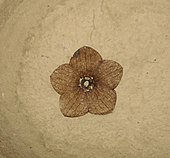 Florissantia quilchenensis | |
|
Malvaceae |
Hibiscus |
Undescribed[38] |
A hibiscus |
||
|
Malvaceae |
† |
Undescribed[54] |
A relative |
||
|
Malvaceae |
Tilia |
†Tilia johnsoni[15] |
Wolfe & Wehr |
A Linden |
 Tilia johnsoni |
|
Malvaceae |
Cf. Tilia |
Undescribed[58] |
Linden relative fruits |
 | |
|
Menispermaceae |
Calycocarpum |
Undescribed[35] |
A moonseed |
||
|
Moraceae |
Morus |
Undescribed[38] |
A mulberry, two types known. |
||
|
Comptonia |
Dawson |
A Comptonia |
|||
|
†Tsukada |
†Tsukada davidiifolia[15] |
Wolfe & Wehr |
A dove-tree relative |
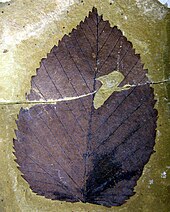 Tsukada davidiifolia | |
|
† |
Undescribed[54] |
Manchester |
A plane tree fruit taxon |
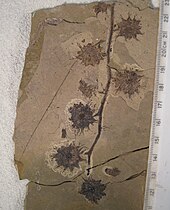 species | |
|
†Macginitiea gracilis[15] |
(Lesquereux) Wolfe & Wehr |
A plane tree relative |
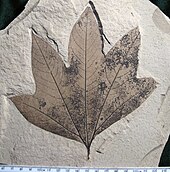 Macginitiea gracilis | ||
|
|
Undescribed[58] |
A sycamore stamen head |
 stamen cluster | ||
|
Polygalaceae |
|
Undescribed[54] |
A milkwort relative |
||
|
Ranunculaceae |
Clematis |
Undescribed[38] |
A Clematis |
 Clematis species | |
|
Rosaceae |
Amelanchier |
Undescribed[38] |
A service berry |
||
|
Rosaceae |
Malus |
Undescribed[17] |
An apple |
||
|
Rosaceae |
Neviusia |
Undescribed[38] |
A snow-wreath |
||
|
Rosaceae |
Oemleria |
†[48] |
, DeVore, & Pigg |
An Osoberry |
|
|
Rosaceae |
†[15] |
Wolfe & Wehr |
A Christmas-berry relative |
 | |
|
Rosaceae |
Prunus |
†[48] |
Benedict, DeVore, & Pigg |
A cherry relative |
 |
|
Rosaceae |
Prunus |
"Species 1"[15] |
A prunoid leaf |
||
|
Rosaceae |
Prunus |
"Species 2"[15] |
A prunoid leaf |
||
|
Rosaceae |
Prunus |
"Species 3"[15] |
A prunoid leaf |
||
|
Rosaceae |
Undescribed[49] |
A firethorn sp.[49] |
|||
|
Rosaceae |
Rubus |
Undescribed[38] |
A blackberry |
||
|
Rosaceae |
A bridal wreath |
||||
|
Rosaceae |
Aff. Sorbus |
A rowan relative |
|||
|
Rosaceae |
Aff. Physocarpus |
Undescribed[23] |
A possible nine-bark |
||
|
Rosaceae |
Cf. Crataegus |
Undescribed[38] |
A hawthorn relative |
||
|
Rosaceae |
Cf. Malus |
Undescribed[49] |
A maloid species possibly apple or pear |
||
|
Rosaceae |
Undescribed[49] |
A bridal wreath relative |
|||
|
Rosaceae |
Cf. Pyrus |
Undescribed[49] |
A maloid species possibly apple or pear |
||
|
Meliosma |
Undescribed[35] |
A Meliosma species |
|||
|
|
Undescribed[35] |
A species |
|||
|
Salicaceae |
Populus |
A cottonwood |
|||
|
Salicaceae |
|
Undescribed[23] |
A |
||
|
Salicaceae |
Salix |
A willow |
|||
|
Sapindaceae |
Acer? |
Heer, 1876 |
A possible maple |
||
|
Sapindaceae |
Acer |
Wolfe & |
A maple |
||
|
Sapindaceae |
Acer |
Wolfe & Tanai |
A maple |
||
|
Sapindaceae |
Acer |
Wolfe & Tanai |
A maple |
||
|
Sapindaceae |
Acer |
Wolfe & Tanai |
A maple |
||
|
Sapindaceae |
Acer |
Wolfe & Tanai |
A maple |
||
|
Sapindaceae |
Acer |
Wolfe & Tanai |
A maple |
||
|
Sapindaceae |
Acer |
Wolfe & Tanai |
A maple |
||
|
Sapindaceae |
Aesculus |
A horse chestnut |
|||
|
Sapindaceae |
† |
†[15] |
(Brown) Wolf & Wehr |
An extinct sapindalean species |
 |
|
Sapindaceae |
& |
||||
|
Sapindaceae |
Koelreuteria |
†[67] |
Wang et al. |
A Koelreuteria species |
 |
|
Sapindaceae |
Becker |
A sapindaceous species |
|||
|
Schisandraceae |
Undescribed[18] |
A kadsura species. |
|||
|
Schoepfiaceae |
Schoepfia |
†[15] |
(LaMotte) Wolfe & Wehr |
A possible Schoepfia relative, |
 |
|
Theaceae |
|
"Species A"[15] |
A theaceous species similar to Gordonia |
||
|
Theaceae |
|
"Species B"[15] |
A theaceous species similar to Cleyera |
||
|
Trochodendraceae? |
† |
Undescribed[54] |
A trochodendroid of uncertain placement.[53] |
||
|
Trochodendraceae |
( et al.) |
A Trochodendrale |
|||
|
Trochodendraceae |
†Pentacentron sternhartae[52] |
et al. |
A Trochodendrale |
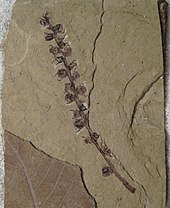 Pentacentron sternhartae | |
|
Trochodendraceae |
Pigg et al. |
A Trochodendrale, |
|||
|
Trochodendraceae |
Trochodendron |
Pigg, Wehr, & |
A Trochodendron |
||
|
Trochodendraceae |
† |
Undescribed[23] |
A trochodendroid of uncertain placement.[53] |
||
|
Ulmaceae |
|
Undescribed[35] |
An elm relative |
||
|
Ulmaceae |
Ulmus |
†[69] |
(Berry) LaMotte |
An elm species |
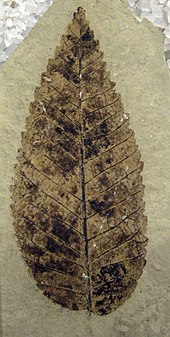 |
|
Ulmaceae |
Ulmus |
†Ulmus okanaganensis |
Denk & Dillhoff |
An elm species, |
 Ulmus okanaganensis |
|
Vitaceae |
Vitis |
||||
|
† |
Undescribed[23] |
A leaf morphotype of uncertain affiliation. |
|||
|
† |
†[54] |
Crane |
A winged fruit of unidentified affinities |
||
|
†Pteronepelys wehrii[70] |
Manchester |
A samara of uncertain affinities. |
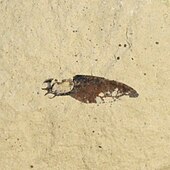 Pteronepelys wehrii | ||
|
|
†[15] |
Wolfe & Wehr |
An incertae sedis angiosperm |
 |
Arthropods[]
The insect fauna of the Klondike Mountain Formation includes representatives from over 13 orders, based on a 1992 estimate, including immature though adult specimens and both terrestrial and aquatic taxa.[71] The most prevalent orders are Diptera and Hemiptera, each making up approximately 30% of the fossil insects known in 1992.
Blattodea[]
| Family | Genus | species | Authors | Notes | Images |
|---|---|---|---|---|---|
|
Undescribed |
Undescribed[17] |
A cockroach |
|||
|
Blattoidae |
Undescribed |
Undescribed[71] |
A blattoidean cockroach |
 Undescribed Blattoidea | |
|
Isoptera |
Undescribed |
Undescribed[71] |
Undescribed termites of uncertain affiliation |
 undescribed isopteran |
Coleoptera[]
A list of Coleopteran families identified by 1992 included Carabidae, Cerambycidae, Chrysomelidae, Curculionidae, Dytiscidae, Elateridae and Lucanidae,[71] but the beetle fauna has not been described in depth yet, with only two weevil species having been fully described.[72][73] A third beetle group belonging to the bean beetle tribe has been identified as palm beetles of the – genus group.[74]
| Family | Genus | Species | Authors | Notes | Images |
|---|---|---|---|---|---|
|
† |
†[72] |
Legalov, 2013 |
An Ithycerinae weevil |
 | |
|
† |
†[73] |
Legalov, 2015 |
An Ithycerinae weevil |
||
|
Carabidae |
Undescribed |
Undescribed[71] |
A ground beetle |
 Unidentified Carabidae | |
|
Cerambycidae |
Undescribed |
Undescribed[71] |
A long-horn beetle |
||
|
Chrysomelidae |
– genus group |
Undescribed[74] |
palm beetles in the tribe . |
||
|
Undescribed |
Undescribed[71] |
A diving beetle |
|||
|
Elateridae |
Undescribed |
Undescribed[71] |
A click beetle |
||
|
Lucanidae |
Undescribed |
Undescribed[71] |
A stag beetle |
Dermaptera[]
The order Dermaptera was first reported in 1992[71] and is known from a series of isolated partial specimens, mostly abdominal sections with the distinct anal forceps attached. Based on the forceps structuring the specimens were tentatively assigned to the modern family Forficulidae, as the oldest North American representatives of the family known at that time.[75]
| Family | Genus | Species | Authors | Notes | Images |
|---|---|---|---|---|---|
|
Unidentified |
"Forficulid species 1"[75] |
A possible forficulid earwig with long cerci |
 "Forficulid species 1" | ||
|
Unidentified |
"Forficulid species 2"[75] |
A possible forficulid earwig with short cerci |
Diptera[]
| Family | Genus | Species | Authors | Notes | Images |
|---|---|---|---|---|---|
|
Undescribed |
Undescribed[71] |
A march fly |
 unidentified Bibionidae | ||
|
Undescribed |
Undescribed[71] |
A fungus gnat |
|||
|
†Metanephrocerus belgardeae[76] |
Archibald, , & Mathewes, 2014 |
A pipunculid big-headed fly |
 Metanephrocerus belgardeae | ||
|
Tipulidae |
Undescribed |
Undescribed[71] |
A crane fly |
 Undescribed Tipulidae |
Ephemeroptera[]
Lewis (1992) listed one species of Heptageniidae mayflies and three specimens that he did not place to family.[71] The Heptageniidae specimen was later described as a squaregill mayfly by Sinitchenkova (1999) and the oldest member of the genus Neoephemera.[77]
| Family | Genus | Species | Authors | Notes | Images |
|---|---|---|---|---|---|
|
, 1999 |
A squaregill mayfly, |
Hemiptera[]
| Family | Genus | Species | Authors | Notes | Images |
|---|---|---|---|---|---|
|
Aphididae |
Undescribed |
Undescribed[71] |
An aphid |
||
|
Undescribed[71] |
An aphrophorid spittlebug |
 Aphrophora species | |||
|
† |
Undescribed[71] |
An aphrophorid spittlebug |
|||
|
† |
Undescribed[71] |
A cercopid froghopper |
|||
|
Undescribed |
Undescribed[71] |
A cercopid froghopper |
 undescribed Cercopidae | ||
|
Fulgoroidea |
Undescribed |
Undescribed[71] |
A frog hopper |
||
|
Undescribed |
Undescribed[71] |
A Shield or stink bug |
 undescribed Pentatomidae |
Hymenoptera[]
A review of the Okanagan highlands hymenoptera published in 2018 identified four "Symphyta" families in the formation Cimbicidae, Pamphiliidae, Siricidae, and Tenthredinidae. Of the "Apocrita" families thirteen are represented, the "Parasitica" families are Braconidae, Diapriidae Ichneumonidae, Proctotrupidae, and Roproniidae while the Vespoidea families are Formicidae, Pompilidae, Scoliidae and Vespidae. Within Apoidea the "Spheciformes" families include Angarosphecidae and Sphecidae while Halictidae is the sole "Apiformes" family known from body fossils. Prunus and Ulmus leaves have been found having damage that is consistent with the damage pattern left by Megachilidae species bees when they remove sections of tissue for nest lining. There are several additional Apoidea fossils that were left as incertae sedis in the group based on the similarity between them and Paleorhopalosoma menatensis, a Paleocene species described from the Menat Formation Auvergne, France. The placement of P. menatensis is uncertain, having been initially described as a member of Rhopalosomatidae, but is possibly an Angarosphecidae or closely related taxon, based on the wing and body morphology.[78]
| Family | Genus | Species | Authors | Notes | Images |
|---|---|---|---|---|---|
|
† |
Undescribed[78] |
An angarosphecid spheciform wasp. |
|||
|
Undescribed |
Undescribed[78] |
An angarosphecid spheciform wasp |
|||
|
Braconidae |
Undescribed |
braconid parasitic wasps |
 Unidentified Braconidae | ||
|
Undescribed |
Undescribed[78] |
A cimbicid sawfly. |
 Unidentified Cimbicidae | ||
|
Undescribed |
Undescribed[78] |
A diapriid diaprioid wasp |
|||
|
Formicidae |
†Klondikia whiteae[79] |
Dlussky & Rasnitsyn, 2003 |
An ant of uncertain subfamily affiliation |
||
|
Formicidae |
Myrmeciites |
"Indesterminate"[80] |
Archibald, , & , 2006 |
A bulldog ant form genus |
 sp. |
|
Formicidae |
Oecophylla |
†[81] |
(Dlussky & Rasnitsyn, 1999) |
An ant, described as Camponotites kraussei, |
|
|
Formicidae |
†Propalosoma gutierrezae[81] |
Dlussky & Rasnitsyn, 1999 |
A bulldog ant, first described as a Rhopalosomatidae wasp, |
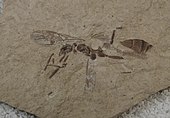 Propalosoma gutierrezae | |
|
Formicidae |
Undescribed |
Undescribed[78] |
Ants of uncertain subfamily placement.[78] |
 Unidentified formicidae | |
|
Halictidae (?) |
Undescribed |
Undescribed[78] |
A possible sweat bee |
||
|
Ichneumonidae |
Undescribed |
Undescribed[78] |
ichneumonid parasitic wasps unplaced to subfamily |
 Undescribed Ichneumonidae | |
|
Megachilidae |
Undescribed |
Undescribed[78] |
Megachilid leaf-cutter bee herbivory trace fossils on leaves |
||
|
†Ulteramus republicensis[84] |
Archibald & Rasnitsyn, 2015 |
A parasitic wasp |
|||
|
Pompilidae |
Undescribed |
Undescribed[78] |
A pompilid spider wasp |
||
|
Undescribed |
Undescribed[78] |
A proctotrupid parasitic wasp |
|||
|
Undescribed |
Undescribed[78] |
A roproniid (sensu lato) proctotrupoid wasp |
|||
|
Undescribed |
Undescribed[78] |
An scoliid wasps |
|||
|
Undescribed |
Undescribed[78] |
A sphecid (sensu stricto) wasp |
|||
|
Undescribed |
Undescribed[78] |
A Tenthredinid sawfly |
|||
|
Vespidae |
Undescribed |
Undescribed[78] |
A vespid wasp |
Lepidoptera[]
A solitary lepidopteran fossil has been recovered, but no full descriptive work has been made on the specimen, aside from a single PhD dissertation. Early examination placed the moth in the family Geometridae, but later work has identified it as the oldest member of the tiger moth subfamily Arctiinae.[85]
| Family | Genus | Species | Authors | Year | Notes | Images |
|---|---|---|---|---|---|---|
|
Undescribed |
Undescribed[85] |
1986 |
An arctiine tiger moth |
Mecoptera[]
A number of mecopteran species belonging to the families Cimbrophlebiidae, Dinopanorpidae, Eorpidae, and Panorpidae are also known.[86]
| Family | Genus | Species | Authors | Year | Notes | Images |
|---|---|---|---|---|---|---|
|
†[86] |
Archibald, 2009 |
2009 |
 | |||
|
†[86] |
Archibald, 2009 |
2009 |
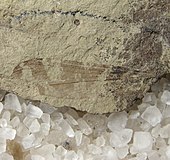 | |||
|
†Dinokanaga andersoni[87] |
Archibald, 2005 |
2005 |
A scorpion fly species |
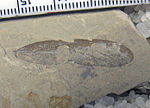 Dinokanaga andersoni | ||
|
†Dinokanaga dowsonae[87] |
Archibald, 2005 |
2005 |
A scorpion fly species |
|||
|
†Dinokanaga sternbergi[87] |
Archibald, 2005 |
2005 |
A scorpion fly species |
|||
|
†Eorpidae |
Archibald, Mathewes, & Greenwood, 2013 |
2013 |
A mecopteran scorpionfly |
 Eorpa elverumi | ||
|
†Eorpidae |
Archibald, Mathewes, & Greenwood, 2013 |
2013 |
A mecopteran scorpionfly, tentatively identified |
 Possible E. ypsipeda[88] |
Neuroptera[]
The neuropteran insects (lacewings and their allies) identified as of 2014 include species from the families Berothidae, Chrysopidae, Hemerobiidae, Ithonidae (including Polystoechotidae), Nymphidae, Osmylidae, and Psychopsidae.[5]
| Family | Genus | Species | Authors | Year | Notes | Images |
|---|---|---|---|---|---|---|
|
Chrysopidae |
† |
†[89] |
& , 2013 |
2013 |
A green lacewing |
|
|
(Makarkin, Archibald, & , 2003) |
2003 |
A hemerobiid lacewing, originally placed in †Cretomerobius, |
||||
|
†Allorapisma chuorum[92] |
Makarkin & Archibald, 2009 |
2009 |
 Allorapisma chuorum | |||
|
†Palaeopsychops marringerae[93] |
Archibald & Makarkin, 2006 |
2006 |
A polystechotid group[94] moth lacewing |
 Palaeopsychops marringerae | ||
|
†Palaeopsychops timmi[93] |
Archibald & Makarkin, 2006 |
2006 |
A polystechotid group[94] moth lacewing |
 Palaeopsychops timmi | ||
|
† |
†[93] |
Archibald & Makarkin, 2006 |
2006 |
A polystechotid group[94] moth lacewing |
 | |
|
† |
†[93] |
Archibald & Makarkin, 2006 |
2006 |
A polystechotid group[94] moth lacewing |
 | |
|
† |
†[93] |
Archibald & Makarkin, 2006 |
2006 |
A polystechotid group[94] moth lacewing |
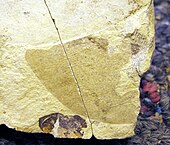 | |
|
Archibald, Makarkin, & Ansorge, 2009 |
2009 |
A nymphid lacewing, possibly a species of †[96] |
||||
|
† |
†[97] |
Makarkin, Archibald, & Mathewes, 2021 |
2021 |
A osmylid lacewing |
||
|
†Ainigmapsychops inexspectatus[5] |
Makarkin & Archibald, 2014 |
2014 |
A possible psychopsid lacewing |
 Ainigmapsychops inexspectatus |
Odonata[]
| Family | Genus | Species | Authors | Year | Notes | Images |
|---|---|---|---|---|---|---|
|
Aeshnidae |
† |
†[98] |
Archibald & Cannings, 2019 |
2019 |
A darner dragonfly |
|
|
Aeshnidae |
† |
†[98] |
Archibald & Cannings, 2019 |
2019 |
A darner dragonfly |
|
|
Aeshnidae |
† |
†[98] |
Archibald & Cannings, 2019 |
2019 |
A darner dragonfly |
|
|
† |
† |
†[99] |
Archibald & Cannings, 2021 |
2021 |
A odonate |
|
|
† |
† |
†[99] |
Archibald & Cannings, 2021 |
2021 |
A odonate |
|
|
† |
† |
†[99] |
Archibald & Cannings, 2021 |
2021 |
A odonate |
|
|
† |
† |
†[99] |
Archibald & Cannings, 2021 |
2021 |
A odonate |
|
|
† |
† |
†[99] |
Archibald & Cannings, 2021 |
2021 |
A odonate |
|
|
† |
† |
†[99] |
Archibald & Cannings, 2021 |
2021 |
A odonate |
|
|
† |
† |
†[99] |
Archibald & Cannings, 2021 |
2021 |
A odonate |
|
|
† |
† |
†[99] |
Archibald & Cannings, 2021 |
2021 |
A odonate |
|
|
† |
† |
†[99] |
Archibald & Cannings, 2021 |
2021 |
A odonate |
|
|
† |
Archibald & Cannings, 2021 |
2021 |
A gossamerwing damselfly. |
|||
|
† |
† |
†[99] |
Archibald & Cannings |
2021 |
A possibly odonate |
 |
Phasmatodea[]
Fossil wings first described in 2015 were identified as being from Susumanioidea stick-insects, a group that had previously been known from the Jurassic to the Paleocene only.[101] Archibald and Bradler (2015) did not place Eoprephasma into Susumaniidae family, maintaining that known characters of the describe specimens did not match taxa in the family, they instead kept the genus as Susumanioidea incertae sedis. Phylogenetic analysis of Susumanioidea published by Yang et al. (2021) resulted in placement of Eoprephasma as the sister group to Renphasma deep within the Susumaniidae subfamily Susumaniinae. The phylogeny produced by Yang et al. indicated a sister group state with the Cretaceous genus Renphasma of China, and placed both as the most derived of the Susumaniinae taxa.[102]
| Family | Genus | Species | Authors | Year | Notes | Images |
|---|---|---|---|---|---|---|
|
†Susumaniidae |
†Eoprephasma hichensi[101] |
Archibald & Bradler, 2015 |
2015 |
A Susumaniinae stick insect species |
Raphidioptera[]
| Family | Genus | Species | Authors | Year | Notes | Images |
|---|---|---|---|---|---|---|
|
† |
Archibald & Makarkin, 2021 |
2021 |
A raphidiid snakefly |
Vertebrates[]
Five species of fish have been identified from the formation, four of which are known from skeletal elements, while the fifth is only known from isolated scales.[104] Of the five species, two are unique to the formation, Hiodon woodruffi and Libotonius pearsoni were both described by paleoichthyologist Mark V. H. Wilson in 1978 and 1979 respectively. The other three species, "Amia" hesperia, , and Eosalmo driftwoodensis, were first described from Okanagan Highlands formations in British Columbia and subsequently also identified from Ferry County fossils. The first notation of fish fossils in the Republic area was by Joseph Umpleby in his 1910 visit to the area, who collected fish near the Tom Thumb Mine, and sent them to the National Museum of Natural History. After examining the fossils, Charles R. Eastman listed the specimens as belonging to the extinct species Amyzon brevipinne in his Fossil fishes in the collection of the United States National Museum.[105] Research tapered off until a series of fish were collected in the Toroda Creek Graben northwest of Republic by R. C. Pearson during his compilation of the Geologic map of the quadrangle, Ferry and Okanogan Counties, Washington. The fossils were tentatively identified by paleoichthyologist David Dunkle as members of the genera Amyzon, , and an undefined salmonid.[106] Pearson sent almost all of the specimens collected to the Smithsonian, but the fossils were never accessioned into the collections there and are now considered lost. He did retain one fossil from the initial collection which was later donated to the USGS collections. The largest single work on the fish of the Okanagan Highlands was published by Mark Wilson in 1977 and covered fossils collected from the known British Columbian Okanagan Highlands fossil sites of the time.[107] While not covering the Washington State fossils, Wilson named two of the species that are currently recognized from the Klondike Mountain Formation Amyzon aggregatum and Eosalmo driftwoodensis. Additionally scales attributed to the genus Amia were discussed and the genus Libotonius was named from fossils in the Allenby Formation.[108][109] In the late 1960s a collection of fish from near the Tom Thumb Mine in Republic was compiled by resident R. Woodward. During the summers of 1976 and 1977 the University of Alberta conducted field collecting in both the Republic and Toroda Creek areas, along with the donation of the Woodward collection, yielded a number of fossil catostomids, along with a single percopsid, a salmonid, a hiodontid, and an Amia scale. The hiodontids were subsequently described as the species Eohiodon woodruffi in 1978 based on differences between the Tom thumb Tuff fossils and those found in British Columbian sites.[106] A year later the percopsid fossils were also described as Libotonius pearsoni, extending the range of the genus south from the Allenby Formation.[108]
Bird fossils are limited to mostly isolated feathers that are preserved in the finer grained strata of the lake bed, though one partial bird skeleton has also been recovered.
| Family | Genus | Species | Authors | Year | Notes | Images |
|---|---|---|---|---|---|---|
|
†"Amia" hesperia |
, 1977 |
1977 |
A bowfin, known from isolated scales |
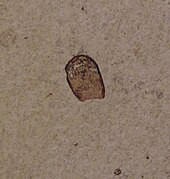 "Amia" hesperia scale | ||
|
Wilson, 1977 |
1977 |
A sucker |
 | |||
|
Unidentified[110] |
(Wilson, 1977) |
1977 |
A sucker, originally identified as Amyzon aggregatum |
|||
|
Salmonidae |
†Eosalmo driftwoodensis[111] |
Wilson, 1977 |
1999 |
A Salmon |
 Eosalmo driftwoodensis | |
|
Hiodontidae |
Hiodon |
Wilson, 1978 |
1978 |
|||
|
†Libotoniidae |
†Libotonius pearsoni[108] |
Wilson, 1979 |
1979 |
A sand roller relative. |
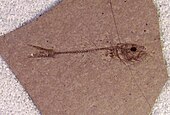 Libotonius pearsoni | |
|
incertae sedis (Aves) |
Unidentified |
"Unnamed"[112] |
2019 |
indeterminate feathers and a skeleton |
 Unidentified feather |
References[]
- ^ Muessig, Siegfried (1962). "Tertiary volcanic and related rocks of the Republic area, Ferry County, Washington". Geological Survey Research 1962. 450 D: D56–58.
- ^ Gaylord, DR; Suydam, JD; Price, SM; Matthews, JM; Lindsey, KA (1996). "Depositional history of the uppermost Sanpoil Volcanics and Klondike Mountain Formation in the Republic basin". Washington Geology. 24 (2): 15–18.
- ^ Cheney, ES; Rasmussen, MG (1996). "Regional geology of the Republic area". Washington Geology. 24 (2): 3–7.
- ^ Suydam, J.; Gaylord, D.R. (1997). "Toroda Creek half graben, northeast Washington: Late-stage sedimentary infilling of a synextensional basin". Geological Society of America Bulletin. 109 (10): 1333–1348. Bibcode:1997GSAB..109.1333S. doi:10.1130/0016-7606(1997)109<1333:tchgnw>2.3.co;2.
- ^ a b c d Makarkin, V.; Archibald, S.B. (2014). "An unusual new fossil genus probably belonging to the Psychopsidae (Neuroptera) from the Eocene Okanagan Highlands, western North America". Zootaxa. 3838 (3): 385–391. CiteSeerX 10.1.1.692.1185. doi:10.11646/zootaxa.3838.3.8. PMID 25081783.
- ^ Umpleby, J. B. (1910). "Geology and ore deposits of Republic mining district". Washington Geological Survey. 1.
- ^ a b c d e f g h Berry, E.W. (1929). A revision of the flora of the Latah Formation (Report). Professional Paper. United States Geological Survey. pp. 225–265. doi:10.3133/pp154h. 154-H.
- ^ Brown, R. W. (1937). "J - Additions to some fossil floras of the Western United States". Shorter contributions to general geology (PDF). Professional Paper. Vol. 186. United States Geological Survey. pp. 163–206. doi:10.3133/pp186J.
- ^ a b Parker, RL; Calkins, JA (1964). "Geology of the Curlew Quadrangle, Ferry County, Washington". Geological Survey Bulletin. 1169.
- ^ Wolfe, J.; Wehr, W. (1991). "Significance of the Eocene fossil plants at Republic, Washington" (PDF). Washington Geology. 19 (3): 18–24.
- ^ Rubino, E.; Leier, A.; Cassel, E.; Archibald, S.; Foster-Baril, Z.; Barbeau, D. Jr (2021). "Detrital zircon UPb ages and Hf-isotopes from Eocene intermontane basin deposits of the southern Canadian Cordillera". Sedimentary Geology. 105969 (online).
- ^ Boleneus, DE; Raines, GL; Causey, JD; Bookstrom, AA; Frost, TP; Hyndman, PC (2001). "Assessment method for epithermal gold deposits in northeast Washington State using weights-of-evidence GIS modeling" (PDF). USGA Open File Report. 01–501: 1–52.
- ^ a b Lasmanis, R (1996). "A historical perspective on ore formation concepts, Republic Mining District, Ferry County, Washington". Washington Geology. 24 (2): 8–11.
- ^ Gaylord, DR; Price, SM; Suydam, JD (2001). Volcanic and hydrothermal influences on middle Eocene lacustrine sedimentary deposits. Republic Basin, northern Washington, USA. International Association of Sedimentologists Special Publication. pp. 199–222. ISBN 9781444304268.
- ^ a b c d e f g h i j k l m n o p q r s t u v w x y z aa Wolfe, J.A.; Wehr, W.C. (1987). Middle Eocene dicotyledonous plants from Republic, northeastern Washington (Report). Bulletin. Vol. 1597. United States Geological Survey. pp. 1–25. doi:10.3133/b1597.
- ^ Archibald, S.; Greenwood, D.; Smith, R.; Mathewes, R.; Basinger, J. (2011). "Great Canadian Lagerstätten 1. Early Eocene Lagerstätten of the Okanagan Highlands (British Columbia and Washington State)". Geoscience Canada. 38 (4): 155–164.
- ^ a b c d e f g h i j k l m n o p q r s t u v Greenwood, D.R.; Archibald, S.B.; Mathewes, R.W; Moss, P.T. (2005). "Fossil biotas from the Okanagan Highlands, southern British Columbia and northeastern Washington State: climates and ecosystems across an Eocene landscape". Canadian Journal of Earth Sciences. 42 (2): 167–185. Bibcode:2005CaJES..42..167G. doi:10.1139/e04-100.
- ^ a b c d e f g h i Wehr, W. "Middle Eocene insects and plants of the Okanogan Highlands". In Martin, J. (ed.). Contributions to the Paleontology and Geology of the West Coast. Seattle, Washington: University of Washington Press. pp. 99–109.
- ^ Joseph, N. L. (1988). "Important Eocene Flora and Fauna Unearthed at Republic, Washington". Rocks & Minerals. 63 (2): 146–151. doi:10.1080/00357529.1988.11761830.
- ^ Arnold, C. A. (1955). "A Tertiary Azolla from British Columbia" (PDF). Contributions from the Museum of Paleontology, University of Michigan. 12 (4): 37–45.
- ^ a b Greenwood, D.R.; Pigg, K.B.; Basinger, J.F.; DeVore, M.L. (2016). "A review of paleobotanical studies of the Early Eocene Okanagan (Okanogan) Highlands floras of British Columbia, Canada, and Washington, U.S.A." Canadian Journal of Earth Sciences. 53 (6): 548–564. Bibcode:2016CaJES..53..548G. doi:10.1139/cjes-2015-0177.
- ^ Hopkins, D.; Johnson, K. (1997). "First Record of cycad leaves from the Eocene Republic flora" (PDF). Washington Geology. 25 (4): 37. Retrieved 29 September 2021.
- ^ a b c d e f g h i j k l m n o p q r s t u Dillhoff, R.M.; Leopold, E.B.; Manchester, S.R. (2005). "The McAbee flora of British Columbia and its relations to the Early-Middle Eocene Okanagan Highlands flora of the Pacific Northwest" (PDF). Canadian Journal of Earth Sciences. 42 (2): 151–166. Bibcode:2005CaJES..42..151D. doi:10.1139/e04-084.
- ^ a b Mustoe, G.E. (2002). "Eocene Ginkgo leaf fossils from the Pacific Northwest". Canadian Journal of Botany. 80 (10): 1078–1087. doi:10.1139/b02-097.
- ^ Mathewes, R. W.; Greenwood, D. R.; Archibald, S. B. (2016). "Paleoenvironment of the Quilchena flora, British Columbia, during the Early Eocene Climatic Optimum" (PDF). Canadian Journal of Earth Sciences. 53 (6): 574–590. Bibcode:2016CaJES..53..574M. doi:10.1139/cjes-2015-0163. hdl:1807/71979.
- ^ a b c d e f g h i j Schorn, H. E.; Wehr, W. C. (1996). "The conifer flora from the Eocene uplands at Republic, Washington". Washington Geology. 24 (2): 22–24.
- ^ Terry, R.; Pyne, M.; Bartel, J.; Adams, R. (2016). "A molecular biogeography of the New World cypresses (Callitropsis, Hesperocyparis; Cupressaceae)". Plant Systematics and Evolution. 302 (7): 921–942. doi:10.1007/s00606-016-1308-4. JSTOR 44853291. S2CID 4236846.
- ^ a b c Chaney, R.W. (1951). "A revision of fossil Sequoia and Taxodium in western North America based on the recent discovery of Metasequoia". Transactions of the American Philosophical Society. 40 (3): 231.
- ^ Schorn, Howard; Wehr, Wesley (1986). "Abies milleri, sp. nov., from the Middle Eocene Klondike Mountain Formation, Republic, Ferry County, Washington". Burke Museum Contributions in Anthropology and Natural History (1): 1–7.
- ^ a b Gooch, N. L. (1992). "Two new species of Pseudolarix Gordon (Pinaceae) from the middle Eocene of the Pacific Northwest". PaleoBios. 14: 13–19.
- ^ LaMotte, R.S. (1944). "Supplement to catalogue of Mesozoic and Cenozoic plants of North America, 1919–37". United States Geological Survey Bulletin. 924: 307.
- ^ Jiao, Y; et al. (2011). "Ancestral polyploidy in seed plants and angiosperms". Nature. 473 (7345): 97–100. Bibcode:2011Natur.473...97J. doi:10.1038/nature09916. PMID 21478875. S2CID 4313258.
- ^ a b c DeVore, ML; Taylor, W; Pigg, KB (2015). "Nuphar carlquistii sp. nov. (Nymphaeaceae): A Water Lily from the Latest Early Eocene, Republic, Washington". International Journal of Plant Sciences. 176 (4): 365–377. doi:10.1086/680482. S2CID 84149074.
- ^ Cevallos-Ferriz, S. R.; Stockey, R. A. (1989). "Permineralized fruits and seeds from the Princeton chert (Middle Eocene) of British Columbia: Nymphaeaceae". Botanical Gazette. 150 (2): 207–217. doi:10.1086/337765. S2CID 86651676.
- ^ a b c d e f Wehr, W.C. (1995). "Paleobotanical Significance of Eocene Flowers, Fruits, and Seeds from Republic, Washington". Washington Geology. 24 (2): 25–2.
- ^ Cevallos-Ferriz, S. R.; Stockey, R. A. (1990). "Vegetative remains of the Magnoliaceae from the Princeton chert (middle Eocene) of British Columbia". Canadian Journal of Botany. 68 (6): 1327–1339. doi:10.1139/b90-169.
- ^ Smith, S. Y.; Stockey, R. A. (2007). "Establishing a fossil record for the perianthless Piperales: Saururus tuckerae sp. nov.(Saururaceae) from the Middle Eocene Princeton Chert". American Journal of Botany. 94 (10): 1642–1657. doi:10.3732/ajb.94.10.1642. PMID 21636361.
- ^ a b c d e f g h i j k l m n o p q r s Wehr, W. C.; Hopkins, D. Q. (1994). "The Eocene orchards and gardens of Republic, Washington". Washington Geology. 22 (3): 27–34.
- ^ Manchester, S.; Pigg, K. (2008). "The Eocene mystery flower of McAbee, British Columbia". Botany. 86 (9): 1034–1038. doi:10.1139/B08-044.
- ^ Erwin, D.M.; Stockey, R.A. (1994). "Permineralized monocotyledons from the middle Eocene Princeton chert (Allenby Formation) of British Columbia: Arecaceae". Palaeontographica Abteilung B. 234: 19–40.
- ^ Erwin, D. M.; Stockey, R. A. (1991). "Silicified monocotyledons from the Middle Eocene Princeton chert (Allenby Formation) of British Columbia, Canada". Review of Palaeobotany and Palynology. 70 ((1-2)): 147–162. doi:10.1016/0034-6667(91)90083-F.
- ^ Cevallos-Ferriz, S. R.; Stockey, R. A. (1988). "Permineralized fruits and seeds from the Princeton chert (Middle Eocene) of British Columbia: Araceae". American Journal of Botany. 75 (8): 1099–1113. doi:10.1002/j.1537-2197.1988.tb08822.x.
- ^ Hesse, M.; Zetter, R. (2005). "Ultrastructure and diversity of recent and fossil zona-aperturate pollen grains". Plant Systematics and Evolution. 255 (3): 145–176. doi:10.1007/s00606-005-0358-9. S2CID 1964359.
- ^ Erwin, D. M.; Stockey, R. A. (1991). "Soleredera rhizomorpha gen. et sp. nov., a permineralized monocotyledon from the Middle Eocene Princeton chert of British Columbia, Canada". Botanical Gazette. 152 (2): 231–247. doi:10.1086/337885. S2CID 85180086.
- ^ Erwin, D. M.; Stockey, R. A. (1992). "Vegetative body of a permineralized monocotyledon from the Middle Eocene Princeton chert of British Columbia". Courier Forschungsinstitut Senckenberg. 147: 309–327.
- ^ Pigg, K. B.; Bryan, F. A.; DeVore, M. L. (2018). "Paleoallium billgenseli gen. et sp. nov.: fossil monocot remains from the latest Early Eocene Republic Flora, northeastern Washington State, USA". International Journal of Plant Sciences. 179 (6): 477–486. doi:10.1086/697898. S2CID 91055581.
- ^ Bogner, J.; Johnson, K. R.; Kvacek, Z.; Upchurch, G. R. (2007). "New fossil leaves of Araceae from the Late Cretaceous and Paleogene of western North America" (PDF). Zitteliana. A (47): 133–147. ISSN 1612-412X.
- ^ a b c Benedict, JC; DeVore, ML; Pigg, KB (2011). "Prunus and Oemleria (Rosaceae) Flowers from the Late Early Eocene Republic Flora of Northeastern Washington State, U.S.A.". International Journal of Plant Sciences. 172 (7): 948–958. doi:10.1086/660880. S2CID 39391439.
- ^ a b c d e f g DeVore, M. L.; Pigg, K. B. (2007). "A brief review of the fossil history of the family Rosaceae with a focus on the Eocene Okanogan Highlands of eastern Washington State, USA, and British Columbia, Canada". Plant Systematics and Evolution. 266 (1–2): 45–57. doi:10.1007/s00606-007-0540-3. S2CID 10169419.
- ^ a b Oh, S.-H.; Potter, D. (2005). "Molecular phylogenetic systematics and biogeography of tribe Neillieae (Rosaceae) using DNA sequences of cpDNA, rDNA, and LEAFY". American Journal of Botany. 92 (1): 179–192. doi:10.3732/ajb.92.1.179. PMID 21652396.
- ^ a b c d e Flynn, S.; DeVore, M. L.; Pigg, K. B. (2019). "Morphological Features of Sumac Leaves (Rhus, Anacardiaceae), from the Latest Early Eocene Flora of Republic, Washington". International Journal of Plant Sciences. 180 (6): 464–478. doi:10.1086/703526. S2CID 198244783.
- ^ a b c d e Manchester, S.; Pigg, K. B.; Kvaček, Z; DeVore, M. L.; Dillhoff, R. M. (2018). "Newly recognized diversity in Trochodendraceae from the Eocene of western North America". International Journal of Plant Sciences. 179 (8): 663–676. doi:10.1086/699282. S2CID 92201595.
- ^ a b c d Manchester, S. R.; Kvaček, Z.; Judd, W. S. (2020). "Morphology, anatomy, phylogenetics and distribution of fossil and extant Trochodendraceae in the Northern Hemisphere". Botanical Journal of the Linnean Society. 195 (3): 467–484. doi:10.1093/botlinnean/boaa046.
- ^ a b c d e f g h i j k l m Wehr, W.C. (1995). "Early Tertiary flowers, fruits and seeds of Washington State and adjacent areas". Washington Geology. 23 (3): 3–16.
- ^ a b c d e Pigg, K.B.; Manchester S.R.; Wehr W.C. (2003). "Corylus, Carpinus, and Palaeocarpinus (Betulaceae) from the Middle Eocene Klondike Mountain and Allenby Formations of Northwestern North America". International Journal of Plant Sciences. 164 (5): 807–822. doi:10.1086/376816. S2CID 19802370.
- ^ Forest, F.; Savolainen, V.; Chase, M. W.; Lupia, R.; Bruneau, A.; Crane, P. R. (2005). "Teasing apart molecular-versus fossil-based error estimates when dating phylogenetic trees: a case study in the birch family (Betulaceae)". Systematic Botany. 30 (1): 118–133. doi:10.1600/0363644053661850. S2CID 86080433.
- ^ Crane, P.; Stockey, R. (1987). "Betula leaves and reproductive structures from the Middle Eocene of British Columbia, Canada". Canadian Journal of Botany. 65 (12): 2490–2500. doi:10.1139/b87-338.
- ^ a b c d Pigg, K.; Wehr, W.C. (2002). "Early Tertiary flowers, fruits and seeds of Washington State and adjacent areas Part-III". Washington Geology. 30 (3–4): 3–16.
- ^ Call, V.B.; Dilcher, D.L. (1997). "The fossil record of Eucommia (Eucommiaceae) in North America" (PDF). American Journal of Botany. 84 (6): 798–814. doi:10.2307/2445816. JSTOR 2445816. PMID 21708632.
- ^ Manchester, S. R.; Dillhoff, R. M. (2004). "Fagus (Fagaceae) fruits, foliage, and pollen from the Middle Eocene of Pacific Northwestern North America". Canadian Journal of Botany. 82 (10): 1509–1517. doi:10.1139/b04-112.
- ^ a b Radtke, M.G.; Pigg, K.B.; Wehr, W.C. (2005). "Fossil Corylopsis and Fothergilla Leaves (Hamamelidaceae) from the Lower Eocene Flora of Republic, Washington, U.S.A., and Their Evolutionary and Biogeographic Significance". International Journal of Plant Sciences. 166 (2): 347–356. doi:10.1086/427483. S2CID 20215269.
- ^ Manchester, S. R. (1991). "Cruciptera, a new Juglandaceous winged fruit from the Eocene and Oligocene of western North America". Systematic Botany. 16 (4): 715–725. doi:10.2307/2418873. JSTOR 2418873.
- ^ Manchester, S.R. (1992). "Flowers, fruits and pollen of Florissantia, an extinct malvalean genus from the Eocene and Oligocene of western North America". American Journal of Botany. 79 (9): 996–1008. doi:10.2307/2444909. JSTOR 2444909.
- ^ a b c d e f g h Wolfe, J.A.; Tanai, T. (1987). "Systematics, Phylogeny, and Distribution of Acer (maples) in the Cenozoic of Western North America". Journal of the Faculty of Science, Hokkaido University. Series 4, Geology and Mineralogy. 22 (1): 1–246.
- ^ Harris, A. J.; Papes, M.; Gao, Y. D.; Watson, L. (2014). "Estimating paleoenvironments using ecological niche models of nearest living relatives: A case study of Eocene Aesculus L.". Journal of Systematics and Evolution. 52 (1): 16–34. doi:10.1111/jse.12053. S2CID 83926177.
- ^ McClain, A. M.; Manchester, S. R. (2001). "Dipteronia (Sapindaceae) from the Tertiary of North America and implications for the phytogeographic history of the Aceroideae". American Journal of Botany. 88 (7): 1316–25. doi:10.2307/3558343. JSTOR 3558343. PMID 11454632.
- ^ a b Wang, Q.; Manchester, S. R.; Gregor, H. J.; Shen, S.; Li, Z. Y. (2013). "Fruits of Koelreuteria (Sapindaceae) from the Cenozoic throughout the northern hemisphere: their ecological, evolutionary, and biogeographic implications". American Journal of Botany. 100 (2): 422��449. doi:10.3732/ajb.1200415. PMID 23360930.
- ^ Pigg, K.B.; Wehr, W.C.; Ickert-Bond, S.M. (2001). "Trochodendron and Nordenskioldia (Trochodendraceae) from the Middle Eocene of Washington State, U.S.A.". International Journal of Plant Sciences. 162 (5): 1187–1198. doi:10.1086/321927. S2CID 45399415.
- ^ Denk, T.; Dillhoff, R.M. (2005). "Ulmus leaves and fruits from the Early-Middle Eocene of northwestern North America: systematics and implications for character evolution within Ulmaceae" (PDF). Canadian Journal of Botany. 83 (12): 1663–1681. doi:10.1139/b05-122. Archived from the original (PDF) on 2017-08-09.
- ^ Manchester, S.R. (1994). "Fruits and Seeds of the Middle Eocene Nut Beds Flora, Clarno Formation, Oregon". Palaeontographica Americana. 58: 30–31.
- ^ a b c d e f g h i j k l m n o p q r s t u v w Lewis, S.E. (1992). "Insects of the Klondike Mountain Formation, Republic, Washington". Washington Geology. 20 (3): 15–19.
- ^ a b Legalov, A. A. (2013). "New and little known weevils (Coleoptera: Curculionoidea) from the Paleogene and Neogene". Historical Biology: An International Journal of Paleobiology. 25 (1): 59–80. doi:10.1080/08912963.2012.692681. S2CID 86584002.
- ^ a b Legalov, A. A. (2015). "Fossil Mesozoic and Cenozoic weevils (Coleoptera, Obrienioidea, Curculionoidea)". Paleontological Journal. 49 (13): 1442–1513. doi:10.1134/S0031030115130067. S2CID 87912009.
- ^ a b Archibald, S.B.; Morse, G.; Greenwood, D.R.; Mathewes, R.W. (2014). "Fossil palm beetles refine upland winter temperatures in the Early Eocene Climatic Optimum". Proceedings of the National Academy of Sciences. 111 (22): 8095–8100. Bibcode:2014PNAS..111.8095A. doi:10.1073/pnas.1323269111. PMC 4050627. PMID 24821798.
- ^ a b c Lewis, S.E. (1994). "Fossil earwigs (Dermaptera) from the Klondike Mountain Formation (middle Eocene) of Republic, Washington". Washington Geology. 22 (1): 39–40.
- ^ Archibald, SB; Kehlmaier, C; Mathewes, RW (2014). "Early Eocene big headed flies (Diptera: Pipunculidae) from the Okanagan Highlands, western North America". The Canadian Entomologist. 146 (4): 429–443. doi:10.4039/tce.2013.79. S2CID 55738600.
- ^ a b Sinitchenkova, N. D. (1999). "A new mayfly species of the extant genus Neoephemera from the Eocene of North America (Insecta: Ephemerida=Ephemeroptera)". Paleontological Journal. 33 (4): 403–405.
- ^ a b c d e f g h i j k l m n o p q r Archibald, S. B.; Rasnitsyn, A. P.; Brothers, D. J.; Mathewes, R. W. (2018). "Modernisation of the Hymenoptera: ants, bees, wasps, and sawflies of the early Eocene Okanagan Highlands of western North America". The Canadian Entomologist. 150 (2): 205–257. doi:10.4039/tce.2017.59. ISSN 0008-347X. S2CID 90017208.
- ^ Dlussky, G. M.; Rasnitsyn, A. P. (2003). "Ants (Hymenoptera: Formicidae) of Formation Green River and some other Middle Eocene deposits of North America". Russian Entomological Journal. 11 (4): 411–436.
- ^ Archibald, S.B.; Cover, S. P.; Moreau, C. S. (2006). "Bulldog Ants of the Eocene Okanagan Highlands and History of the Subfamily (Hymenoptera: Formicidae: Myrmeciinae)" (PDF). Annals of the Entomological Society of America. 99 (3): 487–523. doi:10.1603/0013-8746(2006)99[487:BAOTEO]2.0.CO;2.
- ^ a b Dlussky, G. M.; Rasnitsyn, A. P. (1999). "Two new species of aculeate hymenopterans (Vespida=Hymenoptera) from the Middle Eocene of the United States". Paleontological Journal. 33: 546–549.
- ^ Perfilieva, K. S.; Dubovikoff, D. A.; Dlussky, G. M. (2017). "Miocene ants (Hymenoptera, Formicidae) from Crimea". Paleontological Journal. 51 (4): 391–401. doi:10.1134/S0031030117040098. S2CID 90536477.
- ^ Archibald, S. B.; Rasnitsyn, A. P.; Brothers, D. J.; Mathewes, R. W. (2018). "Modernisation of the Hymenoptera: ants, bees, wasps, and sawflies of the early Eocene Okanagan Highlands of western North America". The Canadian Entomologist. 150 (2): 205–257. doi:10.4039/tce.2017.59. S2CID 90017208.
- ^ Archibald, S.B.; Rasnitsyn, A.P. (2015). "New early Eocene Siricomorpha (Hymenoptera: Symphyta: Pamphiliidae, Siricidae, Cephidae) from the Okanagan Highlands, western North America". The Canadian Entomologist. 148 (2): 209–228. doi:10.4039/tce.2015.55. S2CID 85743832.
- ^ a b Toussaint, E. F.; Condamine, F. L.; Kergoat, G. J.; Capdevielle-Dulac, C.; Barbut, J.; Silvain, J. F.; Le Ru, B. P. (2012). "Palaeoenvironmental shifts drove the adaptive radiation of a noctuid stemborer tribe (Lepidoptera, Noctuidae, Apameini) in the Miocene". PLOS ONE. 7 (7): e41377. Bibcode:2012PLoSO...741377T. doi:10.1371/journal.pone.0041377. PMC 3409182. PMID 22859979.
- ^ a b c Archibald, S. B. (2009). "New Cimbrophlebiidae (Insecta: Mecoptera) from the Early Eocene at McAbee, British Columbia, Canada and Republic, Washington, USA" (PDF). Zootaxa. 2249: 51–62. doi:10.11646/zootaxa.2249.1.5.
- ^ a b c Archibald, S.B. (2005). "New Dinopanorpidae (Insecta: Mecoptera) from the Eocene Okanagan Highlands (British Columbia, Canada and Washington State, USA)". Canadian Journal of Earth Sciences. 42 (2): 119–136. Bibcode:2005CaJES..42..119A. doi:10.1139/e04-073.
- ^ a b c Archibald, SB; Mathewes, RW; Greenwood, DR (2013). "The Eocene apex of panorpoid scorpionfly family diversity". Journal of Paleontology. 87 (4): 677–695. doi:10.1666/12-129. S2CID 88292018.
- ^ Vladimir N. Makarkin; S. Bruce Archibald (2013). "A Diverse New Assemblage of Green Lacewings (Insecta, Neuroptera, Chrysopidae) from the Early Eocene Okanagan Highlands, Western North America". Journal of Paleontology. 87 (1): 123–146. doi:10.1666/12-052R.1. S2CID 130797848.
- ^ Makarkin, VN; Archibald, SB; Oswald, JD (2003). "New Early Eocene brown lacewings (Neuroptera: Hemerobiidae) from western North America". The Canadian Entomologist. 135 (5): 637–653. CiteSeerX 10.1.1.489.5852. doi:10.4039/n02-122. S2CID 53479449.
- ^ Vladimir N. Makarkin; Sonja Wedmann; Thomas Weiterschan (2016). "A new genus of Hemerobiidae (Neuroptera) from Baltic amber, with a critical review of the Cenozoic Megalomus-like taxa and remarks on the wing venation variability of the family". Zootaxa. 4179 (3): 345–370. doi:10.11646/zootaxa.4179.3.2. PMID 27811679.
- ^ Makarkin, V. N.; Archibald, S. B. (2009). "A new genus and first Cenozoic fossil record of moth lacewings (Neuroptera: Ithonidae) from the Early Eocene of North America" (PDF). Zootaxa. 2063: 55–63. doi:10.11646/zootaxa.2063.1.3.
- ^ a b c d e Archibald, S.B.; Makarkin V.N. (2006). "Tertiary Giant Lacewings (Neuroptera: Polystechotidae): Revision and Description of New Taxa From Western North America and Denmark". Journal of Systematic Palaeontology. 4 (2): 119–155. doi:10.1017/S1477201906001817. S2CID 55970660. Retrieved January 27, 2010.
- ^ a b c d e Winterton, SL; Makarkin, VN (2010). "Phylogeny of Moth Lacewings and Giant Lacewings (Neuroptera: Ithonidae, Polystoechotidae) Using DNA Sequence Data, Morphology, and Fossils". Annals of the Entomological Society of America. 103 (4): 511–522. doi:10.1603/an10026. S2CID 49384430.
- ^ Archibald, S. B.; Makarkin, V. N.; Ansorge, J. (2009). "New fossil species of Nymphidae (Neuroptera) from the Eocene of North America and Europe" (PDF). Zootaxa. 2157: 59–68. doi:10.11646/zootaxa.2157.1.4.
- ^ Archibald, S.B.; Makarkin, V.N. (2020). "A new genus and species of split-footed lacewings (Neuroptera) from the early Eocene of western Canada and revision of the subfamily affinities of Mesozoic Nymphidae". The Canadian Entomologist. 152 (3): 269–287. doi:10.4039/tce.2020.10. S2CID 216238397.
- ^ Makarkin, V.N.; Archibald, S.B.; Mathewes, R.W. (2021). "New Protosmylinae (Neuroptera: Osmylidae) from the early Eocene of western North America, with taxonomic remarks". Zootaxa. 4980 (1): 142–156. doi:10.11646/zootaxa.4980.1.9. PMID 34186986. S2CID 235685548.
- ^ a b c Archibald, S. B.; Cannings, R. A. (2019). "Fossil dragonflies (Odonata: Anisoptera) from the early Eocene Okanagan Highlands, western North America". The Canadian Entomologist. 151 (6): 783–816. doi:10.4039/tce.2019.61.
- ^ a b c d e f g h i j Archibald, S. B.; Cannings, R. A.; Erickson, R. J.; Bybee, S. M.; Mathewes, R. W. (2021). "The Cephalozygoptera, a new, extinct suborder of Odonata with new taxa from the early Eocene Okanagan Highlands, western North America". Zootaxa. 4934 (1): zootaxa.4934.1.1. doi:10.11646/zootaxa.4934.1.1. PMID 33756770.
- ^ Archibald, S. B.; Cannings, R. A. (2021). "A new genus and species of Euphaeidae (Odonata, Zygoptera) from the early Eocene Okanagan Highlands locality at Republic, Washington, U.S.A.". Zootaxa. 4966 (3): 392–400. doi:10.11646/zootaxa.4966.3.11. PMID 34186607. S2CID 235557114.
- ^ a b Archibald, SB; Bradler, S (2015). "Stem-group stick insects (Phasmatodea) in the early Eocene at McAbee, British Columbia, Canada, and Republic, Washington, United States of America". Canadian Entomologist. 147 (6): 744. doi:10.4039/tce.2015.2. S2CID 86608533.
- ^ Yang, H.; Shi, C.; Engel, M. S.; Zhao, Z.; Ren, D.; Gao, T. (2021). "Early specializations for mimicry and defense in a Jurassic stick insect". National Science Review. 8 (1). doi:10.1093/nsr/nwaa056. ISSN 2095-5138. PMC 8288419.
- ^ Archibald, S. B.; Makarkin, V. N. (2021). "Early Eocene snakeflies (Raphidioptera) of western North America from the Okanagan Highlands and Green River Formation". Zootaxa. 4951 (1): 41–79. doi:10.11646/zootaxa.4951.1.2. PMID 33903413. S2CID 233411745.
- ^ Wilson, M. V. (1996). "The Eocene fishes of Republic, Washington". Washington Geology. 24 (2): 30–31.
- ^ Eastman, C.R. (1917). "Fossil fishes in the collection of the United States National Museum" (PDF). United States National Museum Proceedings. 52 (2177): 235–304. doi:10.5479/si.00963801.52-2177.235.
- ^ a b c d Wilson, M. V. (1978). "Eohiodon woodruffi n. sp.(Teleostei, Hiodontidae), from the Middle Eocene Klondike Mountain Formation near Republic, Washington". Canadian Journal of Earth Sciences. 15 (5): 679–686. Bibcode:1978CaJES..15..679W. doi:10.1139/e78-075.
- ^ Wilson, M.V. (1977). "Middle Eocene freshwater fishes from British Columbia". Life Sciences Contributions, Royal Ontario Museum. 113: 1–66.
- ^ a b c Wilson, M.V.H. (1979). "A second species of Libotonius (Pisces: Percopsidae) from the Eocene of Washington State". Copeia. 1979 (3): 400–405. doi:10.2307/1443214. JSTOR 1443214.
- ^ Wilson, M. V. (1996). "Fishes from Eocene lakes of the interior". In R. Ludvigsen (ed.). Life in stone: a natural history of British Columbia's fossils. Vancouver, BC: The University of British Columbia Press. pp. 212–224.
- ^ Liu, J. (2021). "Redescription of Amyzon'brevipinne and remarks on North American Eocene catostomids (Cypriniformes: Catostomidae)". Journal of Systematic Palaeontology. 19 (9): 677–689. doi:10.1080/14772019.2021.1968966. S2CID 238241095.
- ^ Wilson, M.V.H.; Li, Guo-Qing (1999). "Osteology and systematic position of the Eocene salmonid †Eosalmo driftwoodensis Wilson from western North America" (PDF). Zoological Journal of the Linnean Society. 99 (125): 279–311. doi:10.1111/j.1096-3642.1999.tb00594.x. Retrieved 2010-01-01.
- ^ Mayr, G.; Archibald, S.B.; Kaiser, G.W.; Mathewes, R.W. (2019). "Early Eocene (Ypresian) birds from the Okanagan Highlands, British Columbia (Canada) and Washington State (USA)". Canadian Journal of Earth Sciences. 56 (8): 803–813. Bibcode:2019CaJES..56..803M. doi:10.1139/cjes-2018-0267. S2CID 135271937.
- Klondike Mountain Formation
- Ypresian Stage
- Geology of the Rocky Mountains
- Paleogene geology of Washington (state)
- Paleontology in Washington (state)




